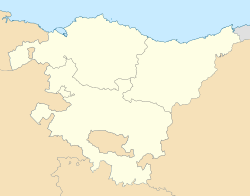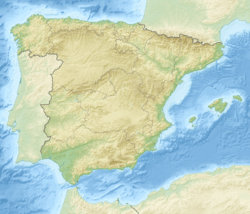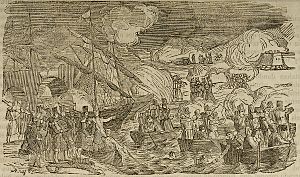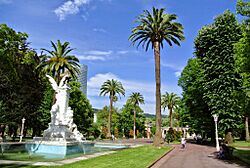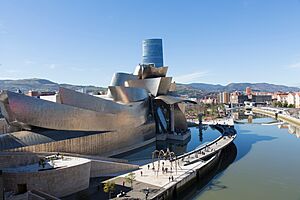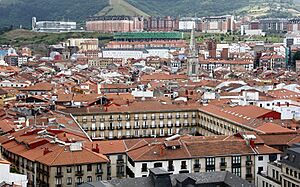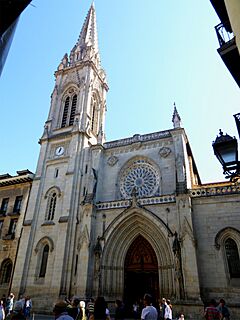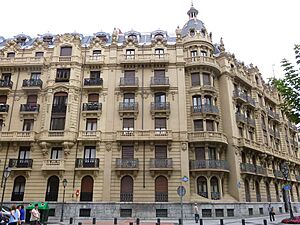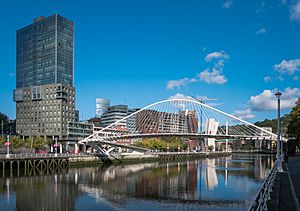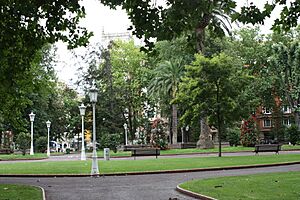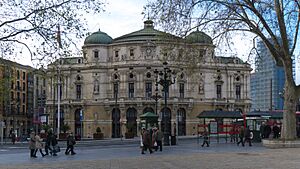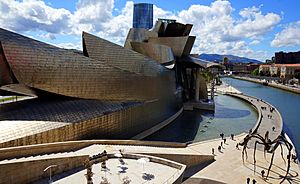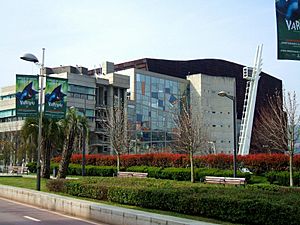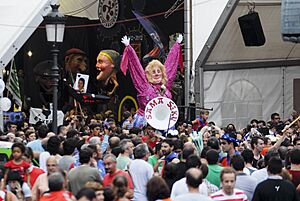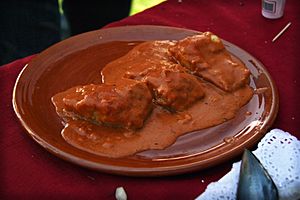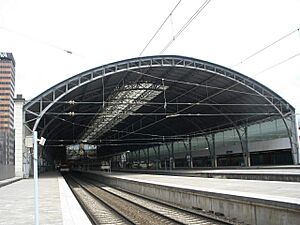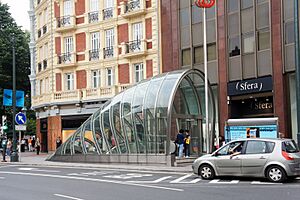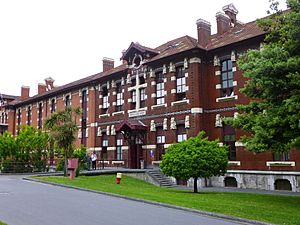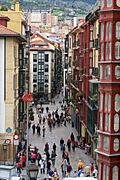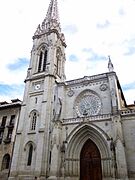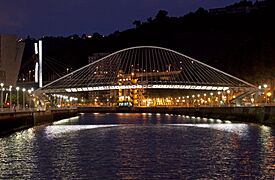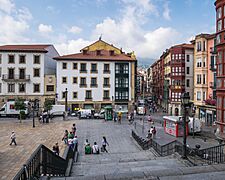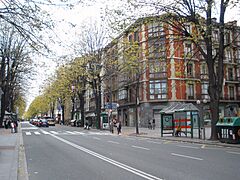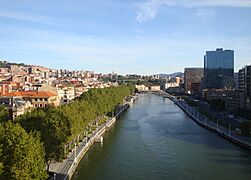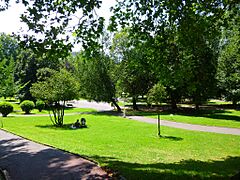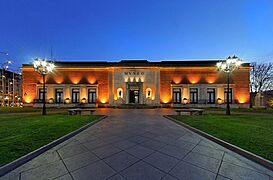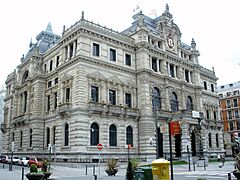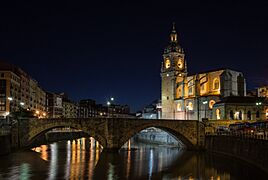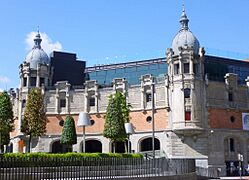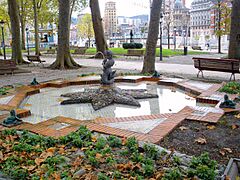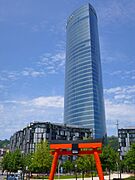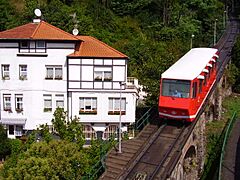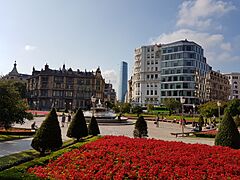Bilbao facts for kids
Quick facts for kids
Bilbao
Bilbo (Basque)
|
|||
|---|---|---|---|
|
Municipality
|
|||
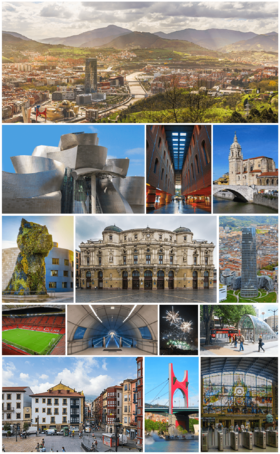
From top left: view of the city; Guggenheim Museum; Azkuna Zentroa; Church of San Antón; Puppy; Arriaga Theatre; Iberdrola Tower; San Mamés Stadium; Uribarri station of the Bilbao metro; fireworks in the Aste Nagusia; fosterito; Miguel de Unamuno Square in the Casco Viejo; La Salve; and Bilbao-Abando railway station
|
|||
|
|||
| Nickname(s):
"The Hole" (Spanish: El Botxo)
|
|||
| Country | |||
| Autonomous community | Basque Country | ||
| Province | Biscay | ||
| Comarca | Greater Bilbao | ||
| Founded | 15 June 1300 | ||
| Founded by | Diego López V de Haro | ||
| Government | |||
| • Type | Ayuntamiento | ||
| • Body | Bilboko Udala | ||
| Area | |||
| • Municipality | 41.50 km2 (16.02 sq mi) | ||
| • Urban | 18.22 km2 (7.03 sq mi) | ||
| • Rural | 23.30 km2 (9.00 sq mi) | ||
| Elevation | 19 m (62 ft) | ||
| Highest elevation | 689 m (2,260 ft) | ||
| Lowest elevation | 0 m (0 ft) | ||
| Population
(2018)
|
|||
| • Municipality | 345,821 | ||
| • Density | 8,333.0/km2 (21,582.5/sq mi) | ||
| • Urban | 775,000 | ||
| • Metro | 1,037,847 | ||
| Demonyms | Bilbaine Basque: bilbotarra Spanish: bilbaíno, bilbaína |
||
| GDP | |||
| • Metro | €32.891 billion (2020) | ||
| • Per capita | €28,801 (2020) | ||
| Time zone | UTC+1 (CET) | ||
| • Summer (DST) | UTC+2 (CEST) | ||
| Postal code |
48001–48015
|
||
| Dialing code | +34 94 | ||
| Official language(s) | Basque Spanish |
||
Bilbao is a large city in northern Spain. It is the biggest city in the Biscay province and the entire Basque Country. Bilbao is the tenth largest city in Spain. About 347,000 people live here as of 2023. The wider Bilbao area has over 1 million residents. This makes it the most populated area in northern Spain.
Bilbao is located about 16 kilometers (10 miles) south of the Bay of Biscay. The city is surrounded by small mountains, about 400 meters (1,300 feet) high. Its weather is influenced by the Bay of Biscay. This means it has mild summers and lots of rain.
The city was founded in the late 1200s by Diego López V de Haro. Bilbao quickly became an important trading center in the Crown of Castile. Its busy port helped export wool and iron from the region to all over Europe.
In the 1800s and early 1900s, Bilbao became a major industrial hub. It was the second most industrial area in Spain, after Barcelona. Many people moved to Bilbao, and the city grew a lot. Today, Bilbao is a modern city focused on services. It has been greatly improved with new buildings and projects. Famous examples include the Bilbao Guggenheim Museum, a new airport terminal, and the metro system.
Bilbao is also home to the Athletic Club football team. This team is special because it only signs players from the Basque region. It is one of Spain's most successful football clubs.
Bilbao has received several awards for its urban development. In 2010, it won the Lee Kuan Yew World City Prize, often called the "Nobel Prize for urbanism". In 2013, its mayor, Iñaki Azkuna, won the World Mayor Prize. In 2017, Bilbao was named the "Best European City 2018".
Contents
- What's in a Name? (Toponymy and Symbols)
- A Look Back in Time (History)
- Where is Bilbao Located? (Geography)
- Who Lives in Bilbao? (Demographics)
- How Does Bilbao Make Money? (Economy)
- What Does Bilbao Look Like? (Cityscape)
- What is There to Do in Bilbao? (Culture)
- How Do People Get Around in Bilbao? (Transport)
- What About Services in Bilbao? (Infrastructure)
- What About Learning in Bilbao? (Education)
- What Sports are Popular in Bilbao? (Sport)
- What are the Main Sights to See? (Main Sights)
- Famous People from Bilbao
- Bilbao's International Friends (International Relations)
- See also
What's in a Name? (Toponymy and Symbols)
The official name of the city is Bilbao. In the Basque language, it is also called Bilbo. Some historians are not sure where the name came from. One idea is that it comes from Basque words for "river" and "cove" (Bil-Ibaia-Bao). Another idea is that it comes from the Spanish words bello vado, meaning "beautiful ford".
What are People from Bilbao Called? (Demonym)
People from Bilbao are called bilbaíno (for boys and men) or bilbaína (for girls and women) in Spanish. In Basque, they are called bilbotar.
The city is also lovingly known as the botxo, which means "hole". This is because it is surrounded by mountains. People from Bilbao are sometimes called botxero because of this nickname.
What are Bilbao's Special Titles?
Bilbao has special historic titles. It is called a "township" (villa). It also has the titles "Very noble and very loyal and unbeaten" (Muy Noble y Muy Leal e Invicta). These titles were given to the city by Spanish kings and queens over many centuries. For example, after a tough battle in 1836, the title "Unbeaten" was added.
What is Bilbao's Coat of Arms?
Bilbao's coat of arms has been used since the 1300s. It shows a bridge with two arches and the Church of San Antón. It also has two black wolves walking on blue and silver waves. The wolves represent the founder of the city, Diego López V de Haro. The bridge and church show the city's connection to the river and its history.
What Does Bilbao's Flag Look Like?
The flag of Bilbao is white with a red square in the top left corner. The colors red and white are the traditional colors of the city. This flag was officially recognized in 1845. It was used by ships from Bilbao and later became the city's official flag.
A Look Back in Time (History)
How Old is Bilbao? (Prehistory and Medieval Times)
People lived in the Bilbao area a very long time ago. Remains of an old settlement from around 300 or 200 BC have been found. Burial sites from 6,000 years ago were also discovered.
Bilbao was founded on June 15, 1300, by Diego López V de Haro. He was the Lord of Biscay. The city was built on the right bank of the Nervión river. It was given special rights and privileges that helped it grow.
In 1310, Bilbao gained more trading rights. It became a required stop for all trade moving from Castile to the sea. This made Bilbao a very important port. In 1372, King John I of Castile made Bilbao a free port. This helped its trade with places like Flanders and Great Britain.
Bilbao Grows and Changes (Modern Age)
In 1511, the Consulate of the Sea was created in Bilbao. This group helped manage the port and improve its facilities. The port of Bilbao became one of the most important in the kingdom. The first printing press arrived in 1577. In 1596, the first book in the Basque language was printed here.
In 1602, Bilbao became the capital of Biscay. The city grew richer, especially after iron was discovered in the nearby mountains. This led to more trade with England and the Netherlands.
Wars and Industry (Contemporary Bilbao)
During the Peninsular War (early 1800s), French troops occupied Bilbao. Later, Bilbao was a key location during the First Carlist War. The city was attacked several times but managed to defend itself.
Despite the wars, Bilbao grew a lot in the 1800s and 1900s. It became the economic heart of the Basque Country. Railways arrived, and important banks like the Bank of Bilbao were founded. Steelmaking industries boomed. The city's population grew from 11,000 in 1880 to 80,000 in 1900. New buildings and avenues were built, making the city more modern.
What Happened During the Spanish Civil War?
The Spanish Civil War started in Bilbao with small uprisings. The city was bombed by Nationalist planes in 1936 and 1937. In May 1937, the Nationalist army surrounded Bilbao. The city fell on June 19, 1937.
After the war, Bilbao focused on industry again. The city was rebuilt, and its airport opened in 1948. The iron industry became very important. Many people moved to Bilbao for work. This led to new social movements. The ETA group was formed in 1959. In the 1960s, new neighborhoods and a university were built.
How Did Bilbao Become a Modern City?
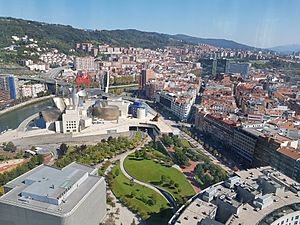
After Spain became a democracy, Bilbao started to change. In the 1980s, the city faced an industrial crisis. But since the mid-1990s, Bilbao has been transforming. It moved from industry to a service economy.
This change started with the opening of the Bilbao Guggenheim Museum in 1997. This museum brought many tourists and new energy to the city. Other projects followed, like the Euskalduna Conference Centre and Concert Hall, the Zubizuri bridge, and the metro system. These projects have made Bilbao a modern and beautiful city.
Where is Bilbao Located? (Geography)
What is Bilbao's Location and Landscape Like?
Bilbao is in the north-central part of Spain. It is about 16 kilometers (10 miles) from the Bay of Biscay. The city covers about 40.65 square kilometers (15.69 square miles). Most of this area is urban, but some parts are mountains. The city is surrounded by mountains like Mount Artxanda and Pagasarri. The highest point in Bilbao is Mount Ganeta, which is 689 meters (2,260 feet) high.
What Rivers are in Bilbao? (Hydrology)
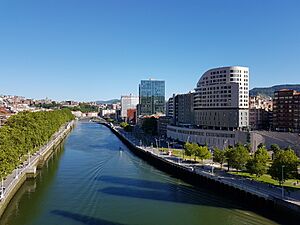
The main river system in Bilbao is the estuary of Bilbao. It is formed where the Nervión and Ibaizabal rivers meet. The estuary flows for about 15 kilometers (9 miles). The river has been changed by people over time. Docks were built, and a canal was dug to help ships.
For many years, the water in the estuary was very polluted. But thanks to efforts to clean it up, the water quality is now much better. You can now see algae, fish, crabs, and seabirds. Sometimes, people even swim in it during summer!
What is Bilbao's Weather Like? (Climate)
Bilbao has an oceanic climate. This means it rains throughout the year, and there isn't a very dry summer. It rains a lot, especially from October to April. Snow is rare in the city, but you might see it on the nearby mountains.
The ocean keeps temperatures mild. Summers are not too hot, usually between 25 and 26°C (77-79°F). Winters are also mild, with average low temperatures between 6 and 7°C (43-45°F).
The hottest temperature ever recorded in Bilbao was 42.9°C (109.2°F) on August 11, 2024. The coldest was -8.6°C (16.5°F) on February 3, 1963. The most rain in one day was 225.6 mm (8.88 inches) on August 26, 1983, which caused big floods.
| Climate data for Bilbao airport: 1981–2010 normals, 1947-2024 extremes | |||||||||||||
|---|---|---|---|---|---|---|---|---|---|---|---|---|---|
| Month | Jan | Feb | Mar | Apr | May | Jun | Jul | Aug | Sep | Oct | Nov | Dec | Year |
| Record high °C (°F) | 24.9 (76.8) |
26.8 (80.2) |
29.8 (85.6) |
33.1 (91.6) |
36.0 (96.8) |
41.2 (106.2) |
42.0 (107.6) |
42.9 (109.2) |
41.7 (107.1) |
33.4 (92.1) |
27.6 (81.7) |
24.7 (76.5) |
42.9 (109.2) |
| Mean daily maximum °C (°F) | 13.4 (56.1) |
14.3 (57.7) |
16.5 (61.7) |
17.6 (63.7) |
20.8 (69.4) |
23.4 (74.1) |
25.4 (77.7) |
26.0 (78.8) |
24.6 (76.3) |
21.4 (70.5) |
16.6 (61.9) |
13.9 (57.0) |
19.5 (67.1) |
| Daily mean °C (°F) | 9.3 (48.7) |
9.7 (49.5) |
11.5 (52.7) |
12.6 (54.7) |
15.7 (60.3) |
18.4 (65.1) |
20.4 (68.7) |
20.9 (69.6) |
19.2 (66.6) |
16.4 (61.5) |
12.4 (54.3) |
9.9 (49.8) |
14.7 (58.5) |
| Mean daily minimum °C (°F) | 5.1 (41.2) |
5.1 (41.2) |
6.4 (43.5) |
7.6 (45.7) |
10.6 (51.1) |
13.4 (56.1) |
15.4 (59.7) |
15.7 (60.3) |
13.8 (56.8) |
11.4 (52.5) |
8.2 (46.8) |
5.9 (42.6) |
9.9 (49.8) |
| Record low °C (°F) | −7.6 (18.3) |
−8.6 (16.5) |
−5.0 (23.0) |
−1.2 (29.8) |
0.4 (32.7) |
3.6 (38.5) |
6.6 (43.9) |
6.8 (44.2) |
3.8 (38.8) |
0.6 (33.1) |
−6.2 (20.8) |
−7.4 (18.7) |
−8.6 (16.5) |
| Average precipitation mm (inches) | 120 (4.7) |
86 (3.4) |
90 (3.5) |
107 (4.2) |
78 (3.1) |
60 (2.4) |
50 (2.0) |
76 (3.0) |
73 (2.9) |
111 (4.4) |
147 (5.8) |
122 (4.8) |
1,134 (44.6) |
| Average precipitation days | 13 | 11 | 11 | 13 | 11 | 7 | 7 | 8 | 8 | 11 | 13 | 12 | 124 |
| Average snowy days | 0.7 | 0.7 | 0.3 | 0 | 0 | 0 | 0 | 0 | 0 | 0 | 0.1 | 0.3 | 2.1 |
| Average relative humidity (%) | 72 | 69 | 68 | 69 | 69 | 70 | 71 | 72 | 71 | 71 | 73 | 72 | 71 |
| Mean monthly sunshine hours | 85 | 97 | 132 | 138 | 169 | 180 | 186 | 179 | 160 | 126 | 88 | 78 | 1,618 |
| Percent possible sunshine | 29 | 33 | 36 | 35 | 37 | 39 | 40 | 42 | 43 | 37 | 30 | 28 | 36 |
| Source 1: Agencia Estatal de Meteorología | |||||||||||||
| Source 2: Agencia Estatal de Meteorología | |||||||||||||
Who Lives in Bilbao? (Demographics)
About 342,397 people lived in Bilbao in 2017. This makes it the largest city in the Basque Autonomous Community. The wider Bilbao area has over 1 million people.
Bilbao's population grew a lot because of industrialization. After reaching a peak in 1982, some areas were separated from the city.
Spanish is the most spoken language in Bilbao. The Basque language is also spoken. About 29% of the population can speak Basque fluently. More than half of Basque speakers are under 30.
Where Do People Come From? (Migration)
| Nationality | Population (2019) |
|---|---|
| 5,866 | |
| 4,069 | |
| 3,424 | |
| 2,133 | |
| 2,016 | |
| 1,880 | |
| 1,877 | |
| 1,815 | |
| 1,267 | |
| 1,162 | |
| 983 |
In 2009, about 32% of people in Bilbao were born in the city. Many others came from other towns in Biscay or other parts of Spain. About 33,537 people were from other countries. The largest groups of foreign-born residents are from Bolivia and Colombia.
How Does Bilbao Make Money? (Economy)
Bilbao is the economic center of the Basque Country. This has been true since the 1500s, thanks to its busy port. In the 1800s, Bilbao's economy grew a lot. This was mainly due to iron mining and steel production. These industries also helped the port and shipbuilding grow.
What About Banks in Bilbao?
Banking became important in Bilbao. The Bank of Bilbao was founded in 1857. Later, it merged with other banks to form BBVA, a large international bank. Local savings banks also merged to form Kutxabank. Bilbao also has a Chamber of Commerce and a Stock Exchange Market.
How Important is the Port?
The historic port was once in the city center. But in the 1900s, a new, larger port was built at the mouth of the estuary. The Port of Bilbao is now one of the top five commercial ports in Spain. It connects Bilbao with 500 ports worldwide. This port activity helps the Basque economy and creates many jobs.
What About Mining and Ironworks?
Iron is a very common material in Biscay. Mining iron was a main activity in Bilbao for a long time. The high-quality iron was sent all over Europe. In the late 1800s, an ironworks industry grew. Bilbao became a major ironworks power, especially during World War I.
Is Tourism Important?
Bilbao became a small beach destination in the late 1800s. But the real boom in tourism happened after the Guggenheim Museum Bilbao opened in 1997. Since then, the number of tourists has grown a lot. In 2018, over 932,000 people visited Bilbao.
Most tourists come from other parts of Spain, like Madrid. Many international visitors come from France, the United Kingdom, Germany, and Italy. Tourism brings about €300 million to the region each year. Bilbao also hosts many business events and conferences.
What Does Bilbao Look Like? (Cityscape)
How Did Bilbao's City Plan Develop? (Urban Planning)
When Bilbao was first built, it had only three streets. These were surrounded by walls. Inside was a small church, now the St. James' Cathedral. Later, four more streets were added, forming the "Seven Streets" (Zazpikaleak). In 1571, the walls were removed to allow the town to grow.
In the late 1800s, Bilbao started to expand. It annexed nearby areas like Abando. New plans were made for wide avenues and modern buildings. The Gran Vía de Don Diego López de Haro became a main street. Over time, more areas were added to Bilbao, making it larger. However, some of these areas later became independent again.
In 2010, Bilbao won the Lee Kuan Yew World City Prize for its excellent urban planning.
What Kind of Buildings are in Bilbao? (Architecture)
Bilbao has many different building styles. You can see Gothic, Art Deco, and modern buildings. The Old Town has the oldest buildings, like the St. James' Cathedral and the Church of San Antón. Most of the Old Town is for walking only during the day. The Basilica of Begoña, a very important church, is also nearby.
Seventeen bridges cross the river in Bilbao. Some famous ones include the Zubizuri (meaning "white bridge"), a pedestrian bridge designed by Santiago Calatrava. The Princes of Spain Bridge is a suspension bridge that was redesigned by artist Daniel Buren. The Deusto Bridge is a bascule bridge, meaning it can open to let ships pass. The Puente Colgante (hanging bridge) is the world's first transporter bridge.
Since the 1990s, old industrial areas have been turned into modern spaces. The Guggenheim Museum Bilbao, designed by Frank Gehry, is a great example. It's considered a masterpiece of modern architecture. The Azkuna Zentroa is another example. It was an old wine warehouse and is now a multi-purpose center. The Iberdrola Tower is the tallest skyscraper in the Basque Country.
What Parks and Gardens Does Bilbao Have?
Bilbao has 18 public parks, covering about 200 hectares (494 acres). The largest parks are Mount Cobetas and Larreagaburu.
The Doña Casilda Iturrizar Park is in the city center. It's an English-style garden with a fountain and a pond full of ducks, geese, and swans. People sometimes call it "Ducks' Park." The Etxeberria Park was built on the site of an old steel mill. It still has the original chimney as a reminder of its past.
Mount Artxanda is easy to reach by a funicular (a type of cable car). At the top, there are restaurants and great views of the city. Mount Pagasarri is popular for hiking. Its natural environment is protected.
What is There to Do in Bilbao? (Culture)
Bilbao was named a "City of Design" by UNESCO in 2014.
Where Can You See a Show? (Theatres)
The main theater in Bilbao is the Arriaga Theatre. It hosts dancing, opera, live music, and plays. Other important places for shows include the Campos Elíseos Theatre and the Euskalduna Concert Hall.
What Museums are in Bilbao?
Bilbao has more than a dozen museums. They cover art, science, and sports. The Guggenheim Museum Bilbao opened in 1997. It is famous for its unique design by Frank Gehry. The museum shows modern art from the second half of the 20th century.
The Bilbao Fine Arts Museum has a great collection of Spanish and European art. It includes works from the 12th century to today. It also has one of the best collections of Basque art.
The Basque Museum shows Basque archaeology and culture. The Maritime Museum Estuary of Bilbao tells the story of the region's fishing and shipbuilding. It has a large crane called Carola, which is a reminder of the old shipyard.
What About Music in Bilbao?
The Euskalduna Concert Hall hosts many music performances. It is home to the Bilbao Symphony Orchestra. The Arriaga Theatre also has many musical events.
Bilbao hosts several music festivals. The Bilbao BBK Live festival is very popular. It features Basque, Spanish, and international pop and rock music. The new San Mamés Stadium also hosts big concerts.
Famous musicians from Bilbao include composer Juan Crisóstomo Arriaga. The Bilbao Choir Society was founded in 1866. Popular bands like Fito & Fitipaldis and Mocedades are from Bilbao.
What Festivals and Events Happen in Bilbao?
Bilbao has many regular festivals. The most important is the Big Week (Aste Nagusia). It happens every year for nine days, starting before August 22. It's the city's main festival and attracts over 1.5 million people.
During the Big Week, the city organizes concerts, plays, Basque rural sports, and fireworks. The festival starts with a small rocket launch called the chupinazo. The symbol of the festival is Marijaia, a large doll that is burned on the last day.
Other smaller festivals happen throughout the year. Many are religious, like celebrations for Saint Agatha and Our Lady of Begoña. Different neighborhoods also have their own local festivals.
Bilbao also hosts the Zinebi International Festival of Documentary and Short Film. It brings together films from around the world.
What Kind of Food Does Bilbao Have? (Cuisine)
Traditional Bilbao dishes often use seafood. Popular dishes include bacalao al pil pil (cod with olive oil and garlic) and bacalao a la vizcaína (salted cod with a special red sauce). Other dishes include hake fish with green sauce and squid in its own ink. For dessert, try canutillos de Bilbao (pastries with custard) or Pantxineta (puff pastries with custard and almonds).
Bilbao is famous for its appetizers called pintxos. These are small slices of bread with different toppings. You can find them in many bars. Other snacks include rabas (fried calamari) and Spanish omelette.
A typical drink from the region is txakoli, a white wine. Cider and patxaran (a sloe-flavored liqueur) are also popular. Many restaurants and bars in the Casco Viejo serve these foods and drinks. Bilbao has many highly-rated restaurants, including some with Michelin stars.
What Languages are Spoken in Bilbao?
Spanish is the most used language in Bilbao. The Basque language is also spoken, but less often than in some other Basque towns. In 2001, about 37% of people could speak Basque. This number has been growing.
According to a 2016 study, 29% of people in Bilbao can speak Basque fluently. Another 19.95% can understand it but speak it with difficulty. The rest, about 51%, do not speak or understand Basque. English is the most common foreign language taught in schools.
| Group | 1981 | 1986 | 1991 | 1996 | 2001 | 2006 | 2011 | 2016 |
|---|---|---|---|---|---|---|---|---|
| Bilinguals: Able to understand and speak both Basque and Spanish | 23.430 | 33.181 | 34.429 | 49.519 | 51.302 | 80.903 | 78.727 | 97.287 |
| Passive bilinguals: Able to understand Basque but cannot speak it, while able to understand and speak Spanish | 47.288 | 63.598 | 65.925 | 66.797 | 71.189 | 63.404 | 96.774 | 67.004 |
| Spanish monolinguals: Unable to understand or speak Basque, only Spanish | 296.703 | 266.045 | 255.210 | 229.336 | 212.485 | 190.483 | 166.869 | 171.441 |
| Population | 367.421 | 362.824 | 355.564 | 345.652 | 334.976 | 334.790 | 342.370 | 335.732 |
How Do People Get Around in Bilbao? (Transport)
What Roads and Highways are in Bilbao?
Bilbao is an important transport hub in northern Spain. It connects to three major motorways. The European route E70 follows the coast, connecting to cities like Santander. The European route E80 connects Bilbao with central Spain and other European cities.
The city also has smaller national and regional roads. The Gran Vía de Don Diego López de Haro is a main street that crosses the city's business district. Bilbao has 14 bridges over the river and tunnels under Mount Artxanda.
What About Airports?
Bilbao is served by Bilbao Airport (BIO). It is the busiest airport in the Basque Country. Over 5.4 million passengers used it in 2018. The airport is about 12 kilometers (7.5 miles) north of the city. Many airlines fly from Bilbao to cities like London, Madrid, and Paris. A new terminal building opened in 2000.
Some low-cost airlines also use the Vitoria Airport (VIT), which is about 59 kilometers (37 miles) south of Bilbao.
What About Trains?
Bilbao has train lines that connect it to Madrid, Barcelona, and other cities in northern Spain. The main station is Bilbao-Abando. High-speed trains are planned to connect Bilbao with other Basque cities and Madrid in the future.
There are also local train services. Euskotren Trena runs a tram line that goes through the city center. It connects important places like the Guggenheim museum and the football stadium. The tram system reopened in 2002 after being closed for many years.
What About Public Transport?
Bilbao has a good public transport system. The Barik card is an electronic ticket that works on almost all public transport.
The Bilbao metro has two lines that connect the city and its surrounding areas. The metro stations were designed by Norman Foster. A third metro line is operated by Euskotren Trena. This line is expected to extend to the airport soon.
There are also urban buses called Bilbobus and regional buses called BizkaiBus. These buses cover areas not reached by trains.
A ferry service connects Santurtzi, near Bilbao, to Portsmouth in the UK.
How Long Do People Travel on Public Transport?
On average, people in Bilbao spend 35 minutes commuting on public transport on a weekday. About 3% of passengers ride for more than 2 hours each day. The average wait time at a stop is 7 minutes. The average distance traveled in one trip is about 6.9 kilometers (4.3 miles).
What About Services in Bilbao? (Infrastructure)
What About Healthcare?
Bilbao has a public healthcare system called Osakidetza. The main hospital in the city is Basurto Hospital. It opened in 1908. Other large hospitals that serve Bilbao are located just outside the city.
What About Utilities?
The headquarters of Iberdrola, a large electricity company, are in Bilbao. This company produces and distributes electricity. There are also oil refineries nearby that produce fuels like gasoline.
The Consorcio de Aguas Bilbao Bizkaia manages the drinking water supply. Water comes from reservoirs fed by the Zadorra river.
What About Learning in Bilbao? (Education)
The Basque Country has a bilingual education system. Students can choose to learn mostly in Basque, mostly in Spanish, or a mix of both. In Bilbao, many primary school students learn mostly in Basque. For older students, Spanish is more common. English is the most popular foreign language taught.
What About Universities?
Bilbao has two universities. The older one is the University of Deusto, founded in 1886. The University of the Basque Country is a public university. Its main campus is outside Bilbao, but some faculties are in the city. Other higher education centers have also opened in recent years.
What Sports are Popular in Bilbao? (Sport)
Like in the rest of Spain, football is the most popular sport. Basketball is also very popular. Some people enjoy Basque rural sports, which are very old. You can watch a Basque pelota match at Bizkaia Frontoia.
Bilbao's location near the sea and mountains means many outdoor activities are popular. Hiking and rock climbing are common in the nearby mountains. Watersports like surfing are popular on the beaches of Sopelana and Mundaka.
What are the Main Sports Clubs?
- Football
The main football club is Athletic Bilbao. They play at the new San Mamés stadium, which can hold over 53,000 fans. Athletic Bilbao is one of the founding members of the Spanish football league, La Liga. They have won the league eight times. The club is known for only signing players who were born in or have strong ties to the Basque region.
- Basketball
The main basketball club is Bilbao Basket. They play in Spain's top division, Liga ACB. Their home is the Bilbao Arena. Bilbao Basket has been runner-up in the Liga ACB and the EuroCup Basketball.
What are the Main Sights to See? (Main Sights)
-
Zubizuri bridge
-
Zubizuri from the other side
-
Metro Bilbao, a work of Norman Foster
-
Funicular to Mount Artxanda
Famous People from Bilbao
- Joaquín Achúcarro (born 1932), a pianist
- José Antonio Aguirre (1904–1960), a football player and first leader of the Basque Government
- Sabino Arana (1865–1903), a politician who founded the PNV party
- Juan Crisóstomo de Arriaga (1806–1826), a composer
- Álex de la Iglesia (born 1965), a film director
- Jon Kortajarena (born 1985), an actor and model
- Miguel de Unamuno (1864–1936), a famous writer and philosopher
- Iñaki Williams (born 1994), a professional football player
Bilbao's International Friends (International Relations)
Bilbao is connected with other cities around the world. These are called "twin towns" or "sister cities".
 Bordeaux, France
Bordeaux, France Buenos Aires, Argentina
Buenos Aires, Argentina Medellín, Colombia
Medellín, Colombia Monterrey, Mexico
Monterrey, Mexico Pittsburgh, United States
Pittsburgh, United States Qingdao, China
Qingdao, China Rosario, Argentina
Rosario, Argentina Sant Adrià de Besòs, Spain
Sant Adrià de Besòs, Spain Tbilisi, Georgia
Tbilisi, Georgia
See also
 In Spanish: Bilbao para niños
In Spanish: Bilbao para niños




